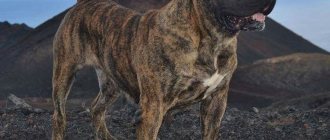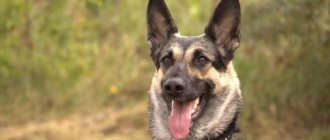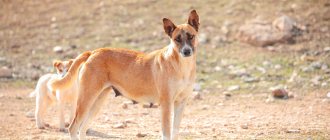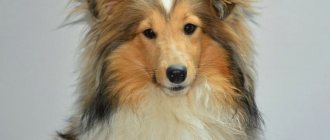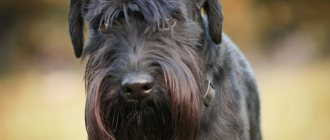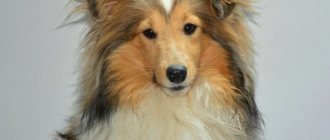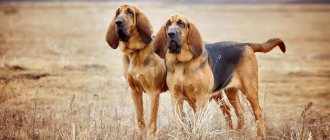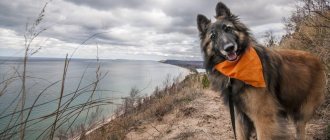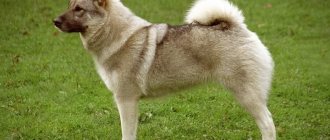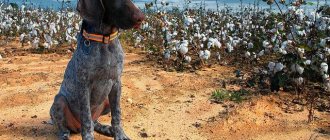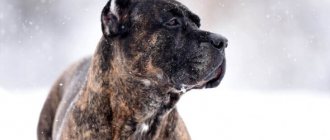Dogo Canarios have a terrifying appearance: powerful jaws with sharp fangs, a massive and muscular body. However, their appearance is very deceptive. In the hands of a person with a strong character, a formidable dog turns into almost a plush toy. In order for the pet not to be dangerous, but to become a devoted and affectionate companion, you need to take into account the peculiarities of upbringing and maintenance of the breed.
Brief history of origin
The Dogo Canario comes from the Canary Islands (Spain). Cynologists have not yet come to a consensus on how this breed developed. According to the most popular version, its ancestors were majoreros (an ancient little-studied breed), indigenous dogs and moloss dogs imported from other countries.
Strong and hardy animals were used for protection and herding. In the 17th century they took part in dog fights. When such entertainment was banned in the 18th century, the breed was on the verge of extinction.
However, Spanish enthusiasts did not allow the Dogo Canarios to become extinct. In 1985, the animals were presented at an exhibition in Las Palmas, the largest city in the Canary Islands.
In 1989, amateur dog breeders working to restore the population developed the first standard, and in 2001 the breed was recognized by the International Film Festival.
Characteristics of the Dogo Canario
| Attachment level | Average |
| Friendliness | Average |
| Child friendly | Average |
| Loyalty to other pets | Average |
| Exercise Needs | High |
| Playfulness | Average |
| Energy level | High |
| Learning ability | High |
| Intelligence | High |
| Tendency to bark | Average |
| Shedding amount | Short |
Interesting Facts
There are several interesting facts associated with this breed:
- In Spanish, the name of the breed is “perro de presso canario.” The animals are also sometimes called “Canarian guard dog” and “Canarian bulldog”.
- Dogo Canarios starred in the movie Chain Dog. The role was played by three dogs named Curly, Ademar and Han Solo.
- A Dogo Canary named Cerberus has become an Internet hero – a black dog with bulging muscles was presented as a symbol of intimidation.
- In New Zealand and Australia, it is prohibited to keep and breed Dogo Canarios, as the breed is considered potentially dangerous.
Breed description, standards and appearance
The Dogo Canario is a strong, well-proportioned, large dog. Its body is somewhat elongated: the length is greater than the height at the withers, but this does not make the animal squat.
When assessing the exterior, judges pay attention to the following proportions:
- the length of the muzzle and skull are related as 2 to 3;
- the width of the skull is 3/5 of the length of the head;
- the distance from the ground to the elbow is equal to half the height (for girls a little less).
Ideal sizes of a Dogo Canario:
- height: 60-66 cm for boys, 56-62 cm for girls;
- weight: 50-65 kg and 40-55 kg respectively.
Dogs with excellent breed characteristics, but 2 cm taller or shorter than the permissible values, do not have their marks reduced at shows.
Description of the Dogo Canary breed (ICF standard No. 346):
- The head is wide, massive, but compact. Covered with loosely hanging thick skin.
- The skull is convex, almost square. The muscles of the cheeks and jaws are well developed.
- The stop is noticeable, but not too sharp. The nasofrontal cavity extends approximately 2/3 of the skull.
- The muzzle tapers slightly towards the lobe. The width of the base is about 2/3 of the width of the skull. The bridge of the nose is straight.
- The nose is wide, with developed nostrils, and well pigmented black. A depigmented lobe is a disqualifying defect.
- The upper lips are slightly drooping and meet in an inverted V shape.
- The jaws are closed in a scissor bite or overshot (no more than 2 mm). A direct bite is not encouraged, but it is not punished either, but it will cause teeth to wear out faster. Undershot is a disqualifying defect.
- The eyes are oval, medium or large. Set wide, not deep and not protruding. The pigmentation of the iris varies from medium to dark brown according to color. Dogs with blue irises or heterochromia are disqualified.
- The ears are small, set wide, slightly above eye level. They hang down the sides of the head. Cropped ears should stand upright.
- The neck is strong, smooth, and has the shape of a cylinder. Its length is slightly less than the length of the head. There is a small suspension at the bottom.
- The body is elongated, wide and strong. The withers are located 1-2 cm below the croup. If the withers are located above the croup, the dog will be disqualified.
- The chest is deep, with well-developed muscles. Lowered to at least the elbows. Its girth is approximately equal to the height at the withers plus 45%. The belly does not sag.
- The tail widens as it approaches the base. When at rest it hangs straight, slightly bending at the end. When moving, the Dogo Canario lifts it in the form of a saber, but never twists it into a ring or throws it over its back. A docked tail is a disqualifying fault.
- The limbs are muscular and spaced quite widely. The paws are compact, with rounded toes. Dark pigmentation of nails is welcome. Light coloring is possible with appropriate coat color.
Intrabreed varieties of the Dogo Canario - Caribbean and Scottish - officially do not exist.
Important. Aggressive and overly shy animals, as well as dogs with physical or behavioral abnormalities, are subject to disqualification.
Colors and coat type
The Dogo Canario has thick, elastic skin that hangs loosely around the neck. If the pet is alert, symmetrical wrinkles appear in the crease on the forehead.
The coat is short, harsh, without undercoat, although it may be present on the neck and back of the thighs. The shortest hairs are located on the ears.
The official description of the Dogo Canario allows for brindle color of any shade - from rich dark to sand. The presence of a minimum number of white markings is allowed:
- on the chest;
- base of the neck;
- pharynx;
- paws.
Dogs with markings in other places will be disqualified.
The mask on the face is always black, but it should not rise above eye level.
Character and behavior
The Dogo Canario has a typical Molosser personality: calm, balanced, alert and noble. Representatives of the breed are devoted to their owner and affectionate with all family members.
They are wary of strangers - these dogs make good watchdogs. However, they will not attack first. The animal goes on the offensive only in case of a clear threat.
Representatives of the breed love children and forgive them many pranks. Canary dogs get along well with other pets, especially if they grow up in the same territory since childhood.
However, these characteristics apply only to well-mannered and well-socialized Dogo Canarios. If you leave a puppy's development to chance, the dog will grow up to be aggressive and disobedient.
Expert opinion
Leonid Rodin
Experienced dog breeder
Ask a Question
Unlike dogoes and mastiffs from other breeds, it seems that the Dogo Canario was able to fully retain all its fighting and leadership qualities acquired over the past centuries. He has not become lazy at all and has not turned into a companion dog who has lost his genetic memory. The entire negative reputation of the Dogo Canario, of course, is based only on unscrupulous owners who overestimated their own strengths and were unable to cope with a difficult dog. A dog that has not gone through the normal stage of socialization and training becomes uncontrollable. He only considers himself the main character, to whom everyone around him must obey. It is not for nothing that experienced experts do not recommend letting your dog walk in front even on a leash. It seems like such a small thing, but it awakens the instinct of the leader, although the vast majority of representatives of other large breeds do not have any problems in such a situation.
Training
These dogs are required to undergo obedience courses. Without experience, you should not try to train a dog on your own. The best option is to undergo training under the guidance of a dog handler.
IMPORTANT! Incorrect upbringing and lack of training will make a Presa Canario puppy an uncontrollable and dangerous pet.
These dogs are quite difficult to train. They want to lead, are stubborn and willful. The main thing in his upbringing is that he unquestioningly obeys his master. To do this, the owner must become a clear leader and leader and always remain so.
Interestingly, Dogo Canarios have a very high level of intelligence. However, the dog does not want to learn, but tries to avoid training with the help of cunning. In these cases, the owner needs to correctly recognize the pet’s behavior and not succumb to its tricks. Otherwise, further difficulties cannot be avoided.
How to choose the right puppy?
There are only a few nurseries in Russia that breed Dogo Canaries. Pedigree puppies must have documents:
- metric;
- veterinary passport;
- dysplasia test results.
Before purchasing, you should inspect the entire litter and pay attention to the conditions in which the dogs are kept - there should be no dirt or excrement in the spacious enclosure.
It is best to choose a puppy who:
- active and playful;
- does not feel shy when meeting a stranger;
- is keenly interested in everything that happens;
- has clear eyes, shiny fur and a moderately well-fed physique.
The fact of purchase is confirmed by a purchase and sale agreement.
Spanish Bulldog or Alano Espanol
Alano from Alano Espanol Kennel
The oldest breed from the Molosser group. The ancestors of Spanish bulldogs came to the Iberian Peninsula in the 5th century along with the Alano tribe. During their formation, the breed became famous as military combat dogs and hunting hunting dogs. Fierce, strong animals with powerful jaws and a death grip accompanied the conquistadors on aggressive campaigns and drove bulls for bullfights.
Alano are excellent guards, hunters and companions, who organically combine self-confidence, innate intelligence, and nobility. They form strong bonds with their family and are patient with children.
Spanish bulldogs were registered in Russia in 2015, and there is a national Alano club. The breed is under consideration by the FCI.
Caring for puppies
The puppy is given to new owners no earlier than 2 months of age. By this age, the little Dogo Canario can already eat solid food - meat, cereals, vegetables. The exact list of products should be obtained from the breeder.
At first, the baby is given only food that is familiar to him. As they grow older, the diet is enriched with offal, sea fish, fruits, and milk is replaced with cottage cheese, kefir and yogurt.
For your information. The puppy can be immediately switched to high-quality industrial food. But up to 6 months, dry granules need to be soaked in water or kefir.
The Dogo Canario's feeding schedule depends on age:
- up to 2 months – up to 8 times a day;
- from 2 to 4 months – 5 times a day;
- from 4 to 5 months – 4 times a day;
- from 5 to 12 months – 3 times a day.
From the year the Dogo Canario is switched to two meals a day.
Care and maintenance of an adult dog
The Dogo Canario does not require painstaking care. He feels good both in a country house and in an apartment.
In summer, the dog can spend a lot of time outdoors. But in winter, the duration of walking will have to be reduced - without an undercoat, the animal cannot withstand the cold.
For your information. Occasionally, the dog can be placed on a chain of at least 5 meters in length.
The right diet
Canary dogs are suitable for two feeding schemes:
- ready-made food of premium and superpremium classes or holistic level;
- natural food.
It is undesirable to mix both options - this can lead to digestive problems.
The basis of the natural diet (50%) of the Dogo Canario is protein food of animal origin - lean meat and offal.
The menu also includes:
- rice and buckwheat porridges;
- dairy products;
- sea fish and eggs (2 times a week);
- greens and vegetables.
During the day, you can treat your dog to pieces of low-fat cheese, apples or pears.
Walking and physical activity
Dogo Canarios are walked twice a day for 40-60 minutes. This is a fairly active breed that needs regular physical activity. However, due to the tendency to diseases of the musculoskeletal system, the animal should not be overly stressed.
Useful exercises:
- running uphill;
- swimming;
- a game of “give and fetch” on level ground.
The Canary Dog, along with the Irish Wolfhound, Caucasian Shepherd Dog, Doberman Pinscher and Bull Terrier, cannot be walked without a muzzle.
Training and education
Dogo Canarios are endowed with high intelligence, but due to their innate stubbornness, they are quite difficult to train. The owner must immediately secure a leadership position and act strictly and persistently.
Important. Cruelly punishing animals is prohibited - the dog will harbor a grudge and get out of control.
It is advisable for the Dogo Canario to undergo OKD. Under the guidance of a professional dog handler, the dog will learn basic commands and obedience, and the person will understand how to manage a headstrong pet.
Care and hygiene
It is enough to wipe the Dogo Canario's coat with a velor cloth about once a week. During the shedding period, which causes almost no inconvenience, a rubber mitten is used - it gently removes dead hair.
The animal's fur is capable of self-cleaning, so bathing is required only when heavily soiled.
Also caring for a Dogo Canario includes:
- cleaning ears and teeth once a week;
- trimming nails as they grow;
- eye examination every 3 days;
- treatment for worms, fleas and ticks.
For preventative purposes, the dog is taken to the veterinarian for examination every six months.
Health
Take your pet to the veterinarian for regular checkups. Such visits will help keep the Dogo Canario’s health under control and begin timely treatment of detected diseases.
Representatives of the breed are not predisposed to serious hereditary diseases; they have strong immune defenses. But, like any living creature, pero de presa often has the following health problems:
- Epilepsy is a disease that cannot be cured, but it can be controlled by reducing the number of seizures accompanied by convulsions.
- Joint dysplasia is characterized by severe pain, sometimes unbearable. Without timely treatment, the dog may lose the ability to move.
- Entropion, eversion of the eyelid cannot be treated and requires surgical intervention.
- Scabies is a skin disease caused by mites.
- Diseases of the gastrointestinal tract - volvulus, bloating, diarrhea.
It is mandatory to get vaccinated on time. Deworming and treatment for skin parasites is also important.
Vaccinations and susceptibility to disease
Dogo Canario vaccination schedule:
- 8-9 weeks: complex vaccine against canine distemper, hepatitis, parainfluenza, leptospirosis, adenovirus;
- after 14-21 days: revaccination;
- 6-8 months (after changing teeth): vaccination against rabies.
Adult dogs are revaccinated every year.
The Dogo Canario dog has been shaped by natural selection for centuries, so it has good health. However, like other large breeds, it is prone to joint problems.
Other characteristic diseases:
- volvulus of the stomach and intestines;
- multifocal retinopathy (damage to the retina);
- epilepsy.
If you properly care for your Dogo Canario, he will live 10-12 years.
Presa Canario diseases
The lifespan of the Dogo Canario is 8–12 years. These dogs do not have breed-specific ailments, but are predisposed to problems characteristic of large animals:
- Hip dysplasia is a congenital deficiency of the articular element, which leads to its deformation and destruction. The first symptoms appear during active growth - from 6–7 months. The pet begins to tuck its paws when walking, has difficulty getting up after sleep, and has difficulty climbing stairs. Only a veterinarian can make a diagnosis based on an x-ray of the limb. The situation can only be corrected by a complex operation to replace the joint with an artificial one, but in mild stages drug therapy (anti-inflammatory, painkillers, chondroprotective drugs) is used in combination with control of nutrition and exercise.
- Gastric volvulus is a twisting of the organ around the esophagus with complete blocking of food movement. The incident can be triggered by activity due to congenital weakness of the ligaments, poor nutrition (too large portions or infrequent meals), rush during meals, active games immediately after the meal. Main symptoms: anxiety, bloating, a sharp reaction to attempts to touch the stomach, moaning, unsuccessful gagging. The disease develops rapidly and it is important to perform surgery on the dog within the first 2–3 hours, otherwise the pet will die.
The Dogo Canario is a Spanish breed that was only recognized by the FCI in 2001. These are large dogs with a calm and proud disposition. In caring for them, proper training and proper nutrition are of primary importance. In matters of wool and walking, these are very comfortable and uncomplicated pets.
